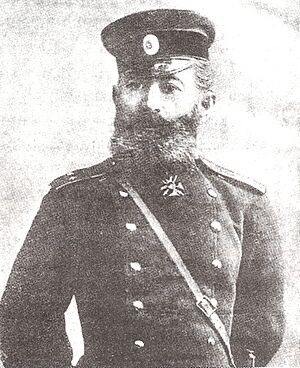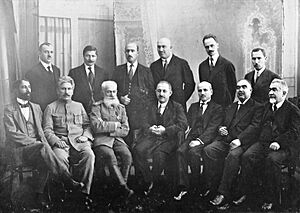Samad bey Mehmandarov facts for kids
Quick facts for kids
Samad bey Mehmandarov
Səməd bəy Mehmandarov |
|
|---|---|
 |
|
| Born | 16 October 1855 Lankaran, Russian Empire |
| Died | 12 February 1931 (aged 75) Baku, Azerbaijan SSR, Soviet Union |
| Allegiance | |
| Service/ |
Imperial Russian Army |
| Years of service | 1875–1918 |
| Rank | General |
| Commands held | Minister of Defense of ADR (25 December 1918 – 1 April 1920) |
| Battles/wars | Conquest of Turkestan Boxer Rebellion Russo Japanese War World War I |
| Awards | Order of Saint Stanislaus Order of St. Anna Order of St. Vladimir Order of St. George Order of the White Eagle Order of St. Alexander Nevsky Knight Commander of the Order of the Bath Knight Commander of the Order of St Michael and St George |
| Relations | Karim bey Mehmandarov |
| Other work | Defence Minister for the Azerbaijan Democratic Republic Defence Advisor to Azerbaijan SSR |
Samad bey Mehmandarov (born October 16, 1855 – died February 12, 1931) was a very important Azerbaijani general. He was a top artillery general in the Imperial Russian Army. Later, he became the Minister of Defense for the Azerbaijan Democratic Republic. He was known for his bravery and leadership in many battles.
Contents
Early Life and Military Training
Samad bey Mehmandarov was born on October 16, 1855. His family was from Shusha, but he was born in Lankaran, which was part of the Russian Empire at the time. His family was noble, meaning they had a high social standing.
He went to military school in Saint Petersburg in 1875. This school was called the 2nd Constantine Military School. After graduating, he became a junior officer, known as a podporuchik. His first assignment was with the 1st Turkestan artillery brigade. Artillery means large guns and cannons used in war.
In 1877, he was promoted to poruchik, a slightly higher rank. Two years later, he moved to the 2nd artillery brigade, also in St. Petersburg.
Military Career and Key Battles
Serving in the Caucasus and Poland
In 1885, Samad bey Mehmandarov became a shtabs-kapitan, which is like a senior captain. He was sent to the 38th artillery brigade in the Caucasus region. He served there for nine years.
In 1894, his brigade moved to Poland. While there, he became part of a military court. In 1898, he was promoted again to lieutenant-colonel. He was put in charge of the 1st battery of the 3rd artillery battalion. A battery is a group of artillery guns.
Fighting in China and the Russo-Japanese War
Later in 1898, Mehmandarov's battery moved to the Transbaikal region. In 1901, he took part in the China Relief Expedition. This was a military action to help people in China. For his brave actions in this battle, he was promoted to colonel. In 1903, he completed a special course at the Officer's Artillery College.
When the Russo-Japanese War started in 1904, Mehmandarov was given command of the 7th Eastern Siberia artillery battalion. He played a key role during the siege of Port Arthur. He was in charge of all the artillery on the Eastern Front. For his excellent service, he was promoted to major general. He also received a special award, the Order of Saint George of IV degree.
After the fortress was captured, the Russian soldiers became prisoners of war. The Japanese commanders offered to let Russian officers go home if they promised not to fight Japan again. Mehmandarov refused this offer. He chose to stay with his soldiers in captivity, showing great loyalty.
World War I Leadership
After returning from captivity in 1906, Mehmandarov was put in charge of the 7th East Siberian Artillery Brigade. A year later, he became the commander of the artillery for the 3rd Siberian Army Corps. In 1908, he was promoted to lieutenant-general.
In 1910, he became the commander of the 1st Caucasus Division. By 1913, he was leading the 21st Infantry Division. He held this position when World War I began. His division was part of the 3rd Caucasus Army Corps.
Under Mehmandarov's command, his division became known as one of the best in the Russian Army. Two regiments, the 81st Apsheron and 83rd Samur, were especially brave. He received the Order of Saint George of III degree for battles in September 1914. He also received the Saint George Sword decorated with diamonds for a battle near Ivangorod in February 1915. This sword was a very rare award. Only eight Russian commanders received it during the entire war.
On December 11, 1914, Mehmandarov was made commander of the 2nd Caucasus Army Corps. His corps fought in some of the toughest battles against German troops. Throughout the entire war, his corps never lost a single piece of artillery to the enemy. On March 22, 1915, Samad bey Mehmandarov was promoted to the highest artillery rank: General of the Artillery. He also received awards from British, French, and Romanian governments.
Role in Azerbaijan
After the February Revolution in Russia, Mehmandarov left the army and moved to Baku. In 1918, the Azerbaijan Democratic Republic (ADR) was formed. Samad bey Mehmandarov became the third and last Minister of Defense for Azerbaijan. He held this important job until April 1920. At that time, the 11th Red Army invaded Azerbaijan.
After the national government fell and Soviet rule began in Azerbaijan, Mehmandarov was arrested. However, he was released two months later. He continued to share his military knowledge. He taught in military schools and advised the military forces of the Azerbaijan SSR. He retired in 1928.
Samad bey Mehmandarov passed away on February 12, 1931, in Baku.


